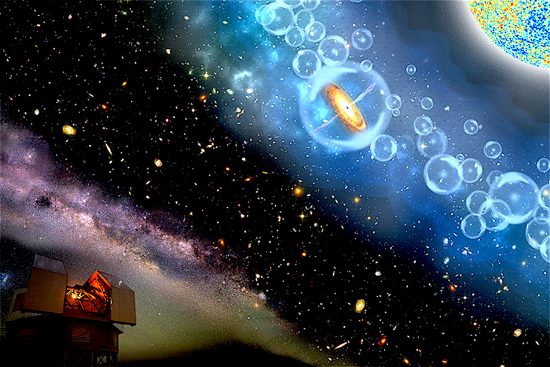
Artist impression of J1342+0928. Credit: Robin Dienel/Carnegie Institute of Science.
Dec 8, 2017
How long it takes things to form in space is a complete mystery.
Black holes continue to elude detection by the most powerful telescopes and radiation sensors, but the consensus community insists that they exist, because they say that they can be inferred by their effect on matter and energy. It is assumed that matter falling into the intense gravity well of a black hole is accelerated and subsequently compressed until it is ultimately destroyed inside the so-called “event horizon”. It is that process that is said to create quasars: rings of hot dust and gas circling a black hole.
According to a recent press release, a quasar, J1342+0928, is far too large and powerful for the time period in which it is supposed to exist. Quasars are conventionally thought to be powered by supermassive black holes. Astronomers believe that the Universe is 13.7 billion years old, and that some events, like star formation or black hole production, should only take place during certain epochs. J1342+0928 is too bright and too energetic to exist in what is supposed to be a few million years after the Big Bang.
In an Electric Universe, quasars and black holes are not related. Primarily because black holes do not exist. Electric star theory suggests that no concentrated gravity from hypothetical objects is necessary. Classical electromagnetism does not depend on the supernatural physics of black holes. Plasma discharge events are commonly known to generate high-energy light. The more electric charge, the higher the frequency of light will be emitted. Supply enough power and X-rays are generated. Instead of “accretion” disks surrounding cosmic plasma discharge phenomena, they are expulsion disks, common in such energetic systems.
For example, infrared and X-ray telescopes confirm the existence of a plasma-focus plasmoid at the Milky Way’s core. The formation is the heart of a galactic circuit. Viewing the core was not possible until the invention of telescopes that can “see” infrared and X-rays that penetrate dust. X-ray radiation from the plasmoid is similar to that given off by highly excited stars, indicating extreme electrical stress. The electric field acts as a particle accelerator.
In a galactic circuit, electrical power flows inward along the spiral arms and is stored in the central plasmoid. When the plasmoid reaches a threshold density, it discharges, usually along the galaxy’s spin axis. This process can be replicated with a plasma focus device.
The discharge forms a jet of neutrons, heavy ions, and electrons. Neutrons decay to form concentrations of matter that appear as quasars. Electromagnetic forces confine the jet to thin filaments that remain coherent for thousands of light-years. The jet usually ends in double layers that extend for many times the size of the galaxy, radiating copiously in radio frequencies. Diffuse electric charge then flows toward the galaxy’s equatorial plane and spiral back toward the core.
There is no evidence that matter can be “infinitely dense”.
Z-pinches in plasma filaments form plasmoids that become stars and galaxies. Electricity is responsible for the birth of stars, and when the current density gets too high the double layers in the circuit catastrophically release their excess energy and appear as gamma ray bursts or X-rays or flares.
X-rays and gamma rays in space are not created in gravity fields. Laboratory experiments most easily produce them by accelerating charged particles through an electric field. No gigantic masses compressed into tiny volumes are necessary, and they are easily generated with the proper models.
There are other factors that should be considered when analyzing data from space before resorting to phantom objects and misleading gravitational ideas.
Stephen Smith












